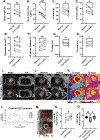Mapping the Unseen: In Vivo CEST-MRI of Creatine Reveals Improved Cardiac Energetics in Subjects with Obesity Following Bariatric Surgery
- PMID: 37058265
- PMCID: PMC11100502
- DOI: 10.1007/s11695-023-06589-0
Mapping the Unseen: In Vivo CEST-MRI of Creatine Reveals Improved Cardiac Energetics in Subjects with Obesity Following Bariatric Surgery
Abstract
Background: Obesity is associated with derangement of cardiac metabolism and the development of subclinical cardiovascular disease. This prospective study examined the impact of bariatric surgery on cardiac function and metabolism.
Methods: Subjects with obesity underwent cardiac magnetic resonance imaging (CMR) at Massachusetts General Hospital before and after bariatric surgery between 2019 and 2021. The imaging protocol included Cine for global cardiac function assessment and creatine chemical exchange saturation transfer (CEST) CMR for myocardial creatine mapping.
Results: Thirteen subjects were enrolled, and 6 subjects [mean BMI 40.5 ± 2.6] had completed the second CMR (i.e. post-surgery), with a median follow-up of 10 months. The median age was 46.5 years, 67% were female, and 16.67% had diabetes. Bariatric surgery led to significant weight loss, with achieved mean BMI of 31.0 ± 2.0. Additionally, bariatric surgery resulted in significant reduction in left ventricular (LV) mass, LV mass index, and epicardial adipose tissue (EAT) volume. This was accompanied by slight improvement in LV ejection fraction compared to baseline. Following bariatric surgery, there was a significant increase in creatine CEST contrast. Subjects with obesity had significantly lower CEST contrast compared to subjects with normal BMI (n = 10), but this contrast was normalized after the surgery, and statistically similar to non-obese cohort, indicating an improvement in myocardial energetics.
Conclusions: CEST-CMR has the ability to identify and characterize myocardial metabolism in vivo non-invasively. These results demonstrate that in addition to reducing BMI, bariatric surgery may favorably affect cardiac function and metabolism.
Keywords: Bariatric surgery; Cardiac function; Chemical saturation exchange transfer; Magnetic resonance imaging; Myocardial energetics; Obesity.
© 2023. The Author(s), under exclusive licence to Springer Science+Business Media, LLC, part of Springer Nature.
Conflict of interest statement
Figures

Similar articles
-
[Left Ventricular Structural and Functional Changes in Obese Subjects With Preserved Left Ventricular Ejection Fraction After Bariatric Surgery: Assessment With Cardiac Magnetic Resonance Imaging].Sichuan Da Xue Xue Bao Yi Xue Ban. 2024 Nov 20;55(6):1410-1417. doi: 10.12182/20241160503. Sichuan Da Xue Xue Bao Yi Xue Ban. 2024. PMID: 39990850 Free PMC article. Chinese.
-
Early benefits of bariatric surgery on subclinical cardiac function: Contribution of visceral fat mobilization.Metabolism. 2021 Jun;119:154773. doi: 10.1016/j.metabol.2021.154773. Epub 2021 Apr 8. Metabolism. 2021. PMID: 33838144 Clinical Trial.
-
CEST MRI reveals a correlation between visceral fat mass and reduced myocardial creatine in obese individuals despite preserved ventricular structure and function.NMR Biomed. 2019 Jul;32(7):e4104. doi: 10.1002/nbm.4104. Epub 2019 May 15. NMR Biomed. 2019. PMID: 31094042 Free PMC article.
-
Effects of bariatric surgery on right ventricular structure and function.J Cardiovasc Med (Hagerstown). 2014 Oct;15(10):731-7. doi: 10.2459/JCM.0000000000000142. J Cardiovasc Med (Hagerstown). 2014. PMID: 24979120 Review.
-
The Early Effects of Bariatric Surgery on Cardiac Structure and Function: a Systematic Review and Meta-Analysis.Obes Surg. 2023 Feb;33(2):453-468. doi: 10.1007/s11695-022-06366-5. Epub 2022 Dec 12. Obes Surg. 2023. PMID: 36508155
Cited by
-
[Left Ventricular Structural and Functional Changes in Obese Subjects With Preserved Left Ventricular Ejection Fraction After Bariatric Surgery: Assessment With Cardiac Magnetic Resonance Imaging].Sichuan Da Xue Xue Bao Yi Xue Ban. 2024 Nov 20;55(6):1410-1417. doi: 10.12182/20241160503. Sichuan Da Xue Xue Bao Yi Xue Ban. 2024. PMID: 39990850 Free PMC article. Chinese.
-
Epicardial adipose tissue, metabolic disorders, and cardiovascular diseases: recent advances classified by research methodologies.MedComm (2020). 2023 Oct 24;4(6):e413. doi: 10.1002/mco2.413. eCollection 2023 Dec. MedComm (2020). 2023. PMID: 37881786 Free PMC article. Review.
References
Publication types
MeSH terms
Substances
Grants and funding
LinkOut - more resources
Full Text Sources
Medical

